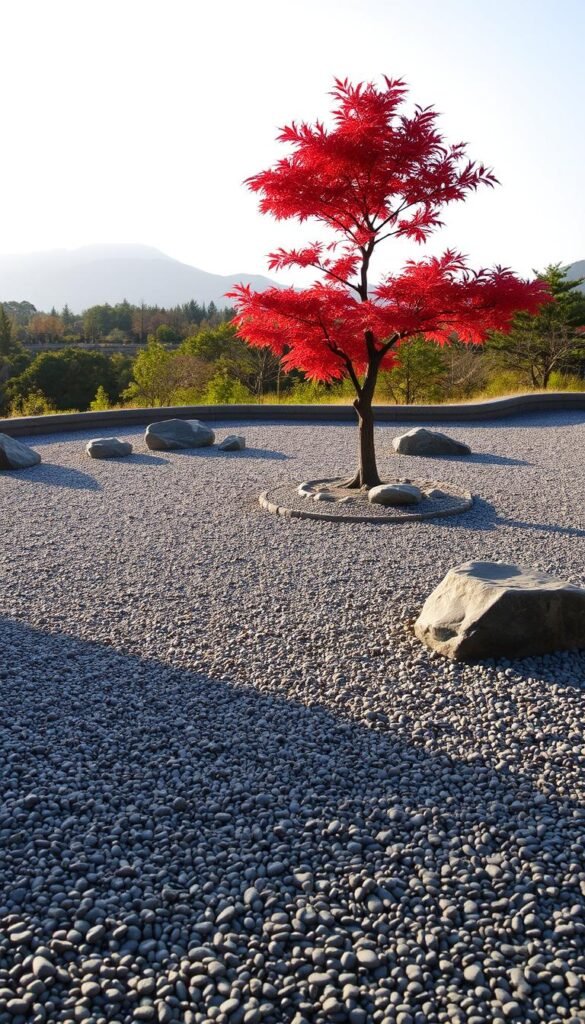Imagine stepping into a space where every element invites calm. Traditional Japanese landscapes use carefully placed stones and flowing gravel patterns to mirror nature’s balance. These designs, rooted in centuries-old practices, turn backyards into havens for quiet reflection.
You don’t need elaborate decorations to craft a soothing environment. The magic lies in intentional arrangements that prioritize harmony over clutter. By focusing on textures like raked sand or moss-covered rocks, you create visual interest without overwhelming the senses.
This approach works for small patios or sprawling yards. Whether you’re working with a balcony corner or an acre, the principles stay the same. We’ll show you how to choose materials that evoke stillness and position them to guide the eye naturally.
You’ll also discover how modern adaptations keep these timeless ideas fresh. From sleek urban courtyards to rustic suburban plots, minimalist layouts prove less truly is more. Ready to build your personal sanctuary? Let’s begin.
Understanding the Zen Garden Philosophy
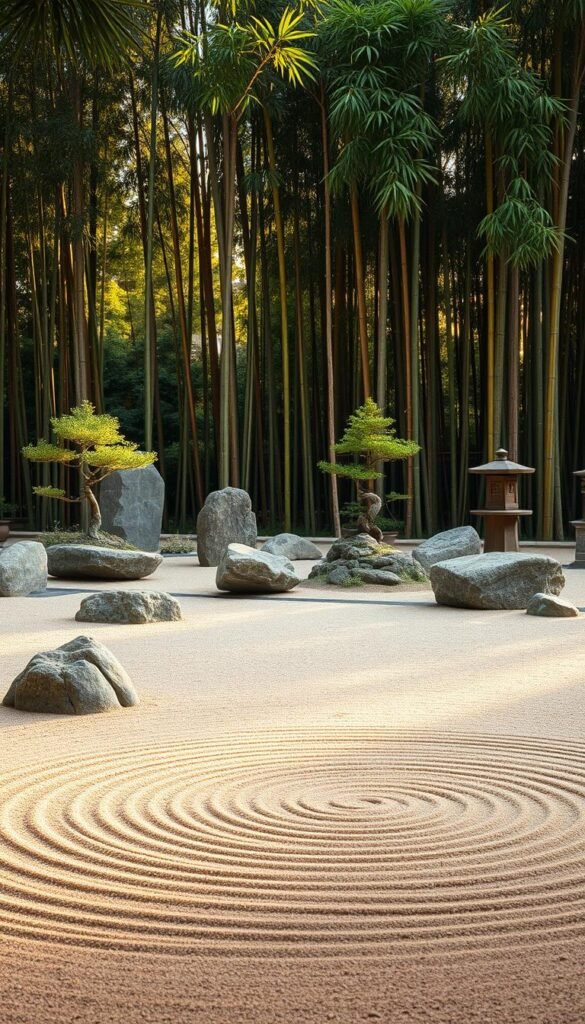
Spaces shaped by silence teach us more than crowded landscapes ever could. These arrangements began as tools for zen buddhist monks to deepen their meditation practices, using natural materials to mirror mental clarity. Every rock placement and gravel swirl carries intention—not decoration.
Embracing Minimalism and Simplicity
Less becomes powerful when each item earns its place. You might use five stones instead of fifty, but their positions create a sense of movement. This approach lets your mind relax instead of jumping between competing elements.
Empty areas matter as much as filled ones. Think of gravel patterns as water currents—their flow guides attention without shouting. Your space becomes a map for calm thoughts.
The Role of Meditation in Design
Original zen gardens weren’t made for Instagram photos. Buddhist monks designed them to support seated contemplation. When you rake sand into waves or position a mossy boulder, you’re continuing a 700-year-old mindfulness practice.
Try this: place one stone where you’ll see it daily. Let its steady presence remind you to breathe deeply. Over time, your garden becomes a teacher of tranquility.
History and Cultural Significance of Zen Gardens
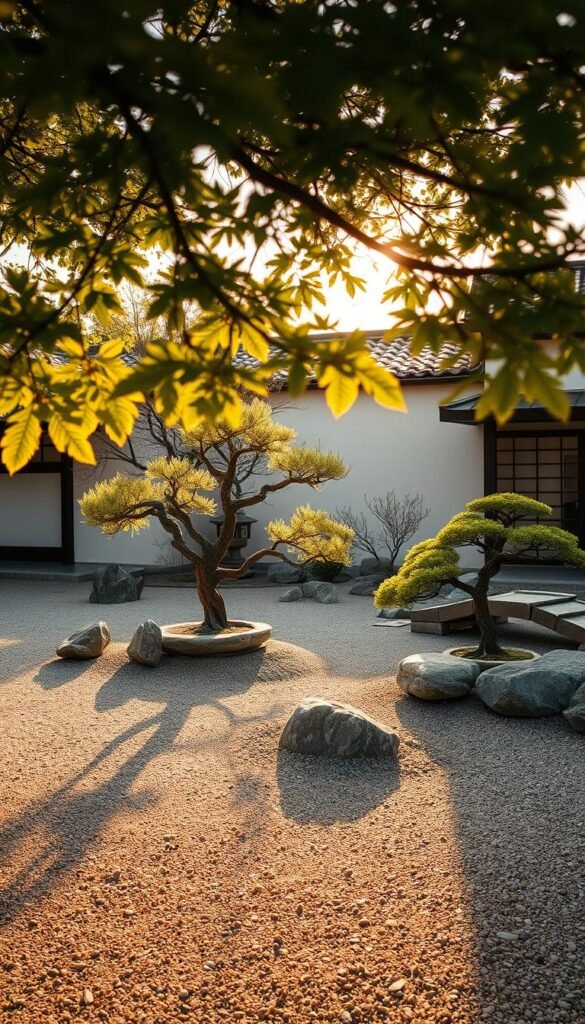
The story of these landscapes begins not with beauty, but with spiritual necessity. What started as monastic tools evolved into artistic expressions that still captivate us today. Let’s explore how war, philosophy, and daily practice shaped their development.
Origins and Evolution in Japanese Culture
Chinese garden ideas arrived in Japan during the 8th century, blending with local traditions. The Heian period’s Sakuteiki—the oldest gardening manual—first described dry landscape designs using stones to represent waterfalls or islands. By the 14th century, Japanese rock gardens became meditation aids for temple communities.
| Period | Development | Cultural Impact |
|---|---|---|
| Heian (794-1185) | First written records of stone arrangements | Shift from decorative ponds to symbolic dry elements |
| Kamakura (1336-1392) | Zen Buddhism spreads; temple gardens emerge | Monks use gardens for seated meditation practices |
| Muromachi (1336-1573) | Karesansui style gains popularity post-wars | Affordable designs make tranquility accessible |
Influence of Zen Buddhist Practices
Buddhist monks like Muso Soseki transformed barren spaces into mind-training tools. Raking gravel wasn’t just maintenance—it became moving meditation. Each stone’s placement taught lessons about impermanence and focus.
After the Onin War, these gardens spread beyond temples. Their simplicity offered peace during chaotic times. Today, their legacy reminds us that stillness grows from intentional design.
Key Elements of a Traditional Japanese Zen Garden
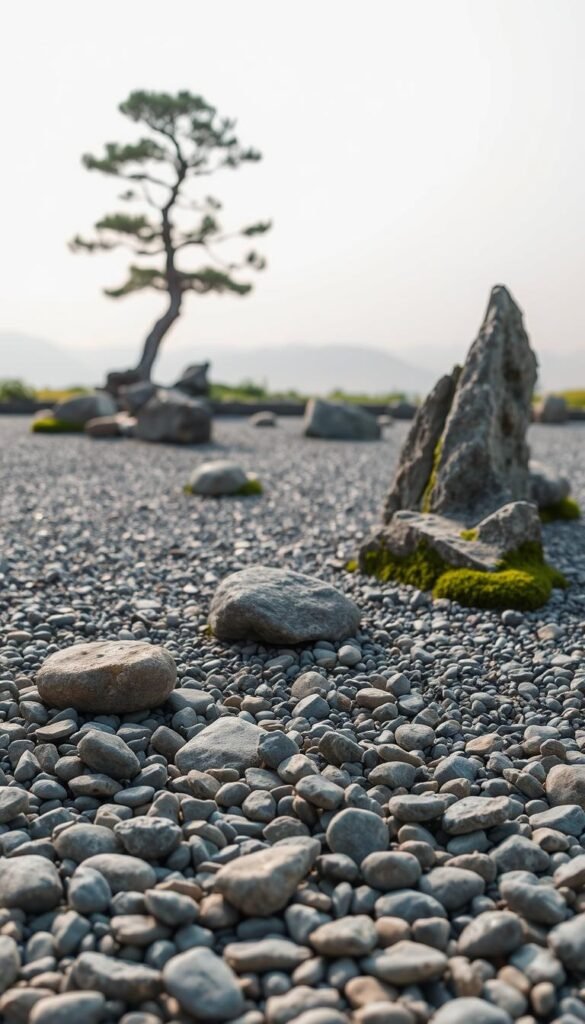
At the heart of every peaceful retreat lie two core components: earth and motion. These landscapes use rocks as anchors and flowing gravel to mimic nature’s rhythms. Together, they form a dialogue between permanence and change.
Rocks, Stones, and Their Symbolism
Large boulders aren’t just decorations—they’re storytellers. Vertical stones might symbolize mountains, while flat ones become islands in your gravel “sea.” Place them where they look natural, as if they’ve always belonged there.
Smaller pebbles often outline pathways or dry streambeds. Their irregular shapes mirror how water smooths edges over time. Choose stones with interesting textures to add depth without clutter.
| Stone Type | Common Use | Symbolic Meaning |
|---|---|---|
| Tall vertical | Focal points | Mountain peaks |
| Flat slabs | Stepping paths | Islands |
| Rounded | Water features | River stones |
Raked Gravel or Sand Patterns
Your rake becomes a paintbrush here. Swirling lines in suna (gravel) can show water ripples or wind currents. Start with simple parallel lines—they’re calming to make and watch.
Use pea-sized gravel for best results. It stays put in rain but moves easily under your tools. Patterns change with your mood, reminding you that nothing stays the same.
Zen Garden Aesthetic: Creating Spaces with Gravel, Stones, and Minimal Plants
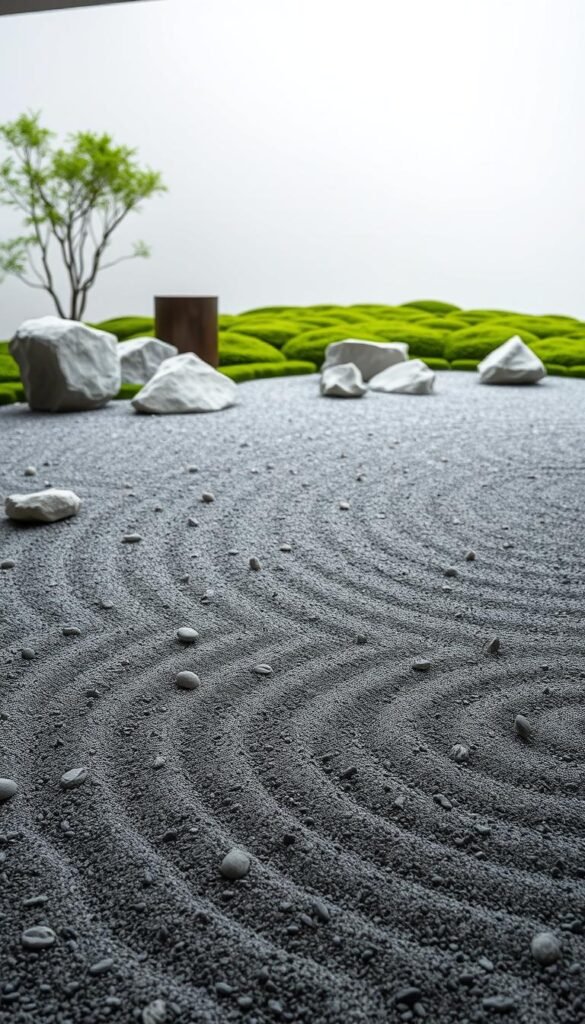
What transforms ordinary materials into a meditation tool? It’s how you arrange them. Dry landscapes thrive on contrasts—rough stones against smooth sand, angular boulders beside flowing gravel patterns. Each choice whispers rather than shouts.
Start with your “canvas”—a bed of crushed granite or fine sand. Rake swirling lines to mimic water currents. These patterns change with light and weather, reminding you that stillness contains motion.
Select stones that tell stories. Tall, jagged rocks become distant peaks. Flat slabs anchor the scene like islands in a silent sea. Odd numbers work best—three or five create natural asymmetry.
| Element | Purpose | Visual Effect |
|---|---|---|
| Gravel patterns | Show movement | Dynamic calm |
| Stone arrangements | Anchor composition | Stable focal points |
| Plant choices | Softens edges | Natural framing |
Limit greenery to moss or small shrubs. Their muted greens let stones take center stage. Japanese maple works if space allows—its delicate leaves flutter like falling water.
Texture matters most. Run your hand over pebbles—feel their smoothness. Contrast this with a boulder’s rugged surface. These tactile experiences ground you in the present moment.
Your space becomes a mirror for the mind. Empty areas aren’t blank—they’re breathing room for thoughts. Every raked line guides the eye gently, never demanding attention.
Designing Your Outdoor Space: Planning and Layout
Your outdoor area becomes a retreat when you shape it with purpose. Focus on how sunlight shifts across your space and where you naturally pause to relax. These observations guide decisions that blend practicality with calm.
Choosing the Right Location and Pathways
Pick spots that feel sheltered yet open. A corner shielded by fencing or shrubs creates intimacy. For pathways, use materials like flat stepping stones spaced for slow walking. Gravel works well—its crunch underfoot adds a meditative rhythm.
Using Asymmetry for Natural Balance
Nature rarely mirrors itself. Place three varied-sized rocks off-center, letting empty areas breathe. A single Japanese maple beside a winding path gives tranquility without perfect symmetry. This approach builds visual interest while keeping a sense of ease.
Remember: your garden grows with you. Start small, observe how light and seasons interact, then refine. Even basic layouts can become sanctuaries when designed thoughtfully.

